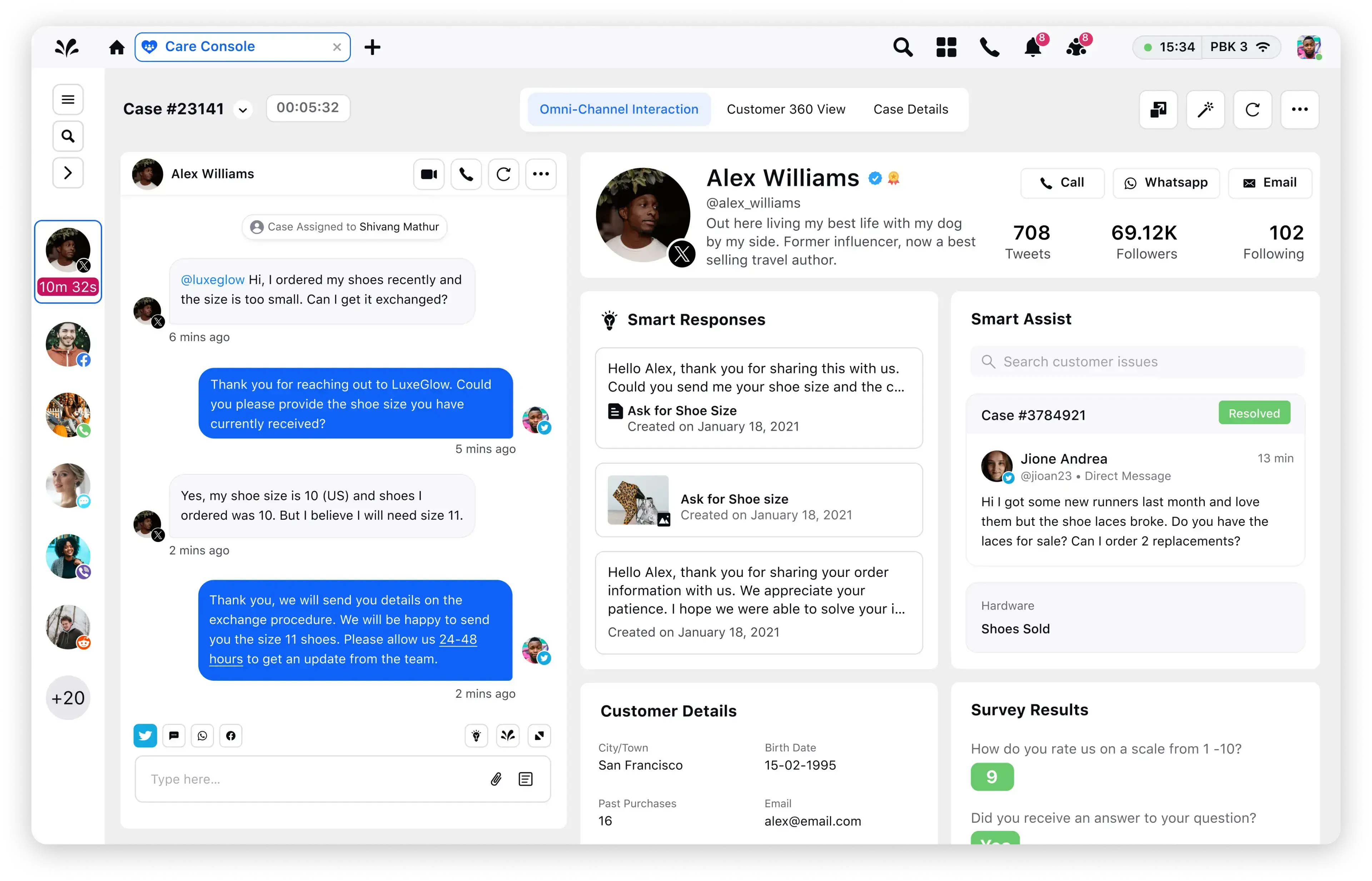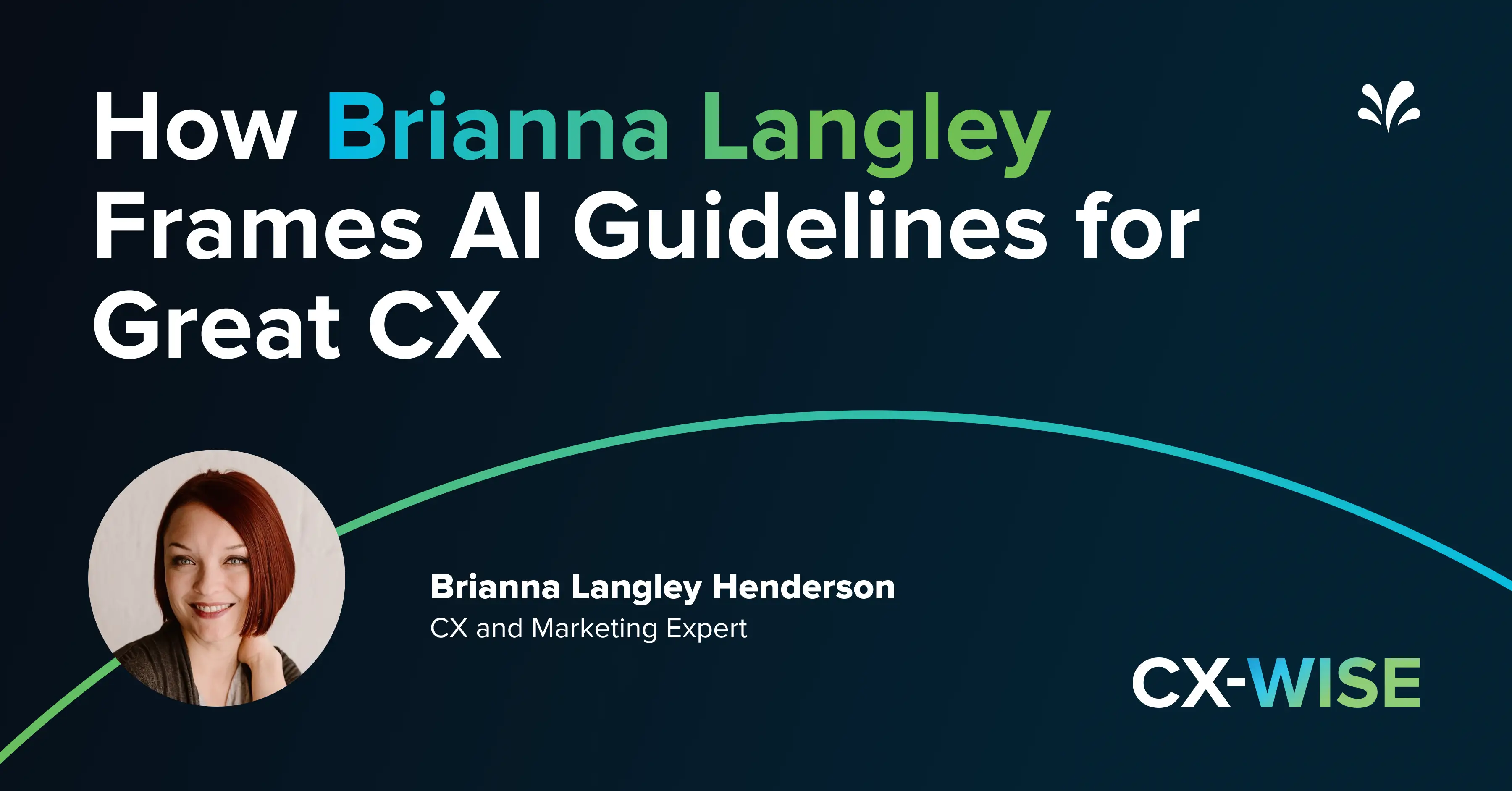The AI-first unified platform for front-office teams
Consolidate listening and insights, social media management, campaign lifecycle management and customer service in one unified platform.

The Refreshing Approach: Why Your Brand Is Only as Strong as the Experience You Deliver
Almost every interaction we have today with a brand can in some shape or form be considered customer experience (CX).
Think about it: when you order dinner on your favorite food delivery app after a long day's work, every touchpoint in that journey could make or break your day. From browsing the app for your favorite comfort food to receiving personalized options tailored to your needs:
- No seafood because you're allergic
- No dessert because you're off sugar this month
- Napkins and utensils thoughtfully included
Each element is designed to make the ordering process frictionless, thereby creating a memorable experience. The process comes full circle when your order arrives on time with a note reading: "I hope your day was as memorable as our dipping sauce."
Now wouldn’t that bring a smile to your face?
Customer experience is rooted in every interaction a customer has with a brand. This means it exists everywhere within the brand ecosystem.
In today's market, almost any product or service can be replicated, so what truly stands the test of time is the experience customers have during and after their purchase. To ensure seamless experiences, aligning your brand offering with your CX is more important than ever.
Sprinklr's Chief Administrative Officer and brand connoisseur Joy Corso breaks down the process of bridging brand experience with CX to create refreshing customer experiences, and “finding your golden nugget.”
Let's dive right in.
Brand experience and customer experience: Two sides of the same coin
Milk and cookies, peanut butter and chocolate, the Super Bowl and cool ads, Instagram and avocado toast.
Allow us to add another iconic duo to this list: Brand experience (BX) and CX.
"Your brand is your experience, and your experience is your brand," Corso says.
While this phrase suggests brand and experience are interchangeable, many companies remain siloed when delivering on both fronts. CX predominantly sits on the sales and support side, with agents addressing real-time inquiries while the operations team handles delivery. Meanwhile, the brand sits on the marketing side, promising guaranteed two-day shipping.
When you promise one thing and deliver another, customers inevitably become frustrated by the lack of accountability. For instance, if you order pizza from a chain that promises "hot and fresh" pies every time, you certainly wouldn’t appreciate a cold, hard pizza delivered an hour late.
BX and CX need to exist as a single unit across organizations. Forrester’s recent study shows clear and compelling evidence that the two work more effectively together to generate financial value.
Forrester's analyses across various categories indicate that enhancing both BX and CX has a revenue impact compared to advancing just one of them. While the boundaries between BX and CX remain murky in most companies today, the demarcation between the two has all but disappeared in the minds of customers. Companies that fail to recognize and embrace this duality risk becoming irrelevant in consumers’ eyes.
The balance between employee experience and customer experience
Employee experience (EX) and CX are so intrinsically linked that when one falls, so does the other, like a house of cards.
Corso elaborates that there is a vital component of CX tucked away in almost every function in an organization. Her career began in marketing and has led her to take charge of culture and talent here at Sprinklr. As she advocates for strengthening the relationship between EX and CX, Corso asks:
"Employee experience and customer experience: Are they really that different?"
As more customers look to align their purchase decisions with their values, they have become increasingly interested in how their favorite brands engage with employees. Customers tend to prioritize doing business with companies that value their employees, treat them fairly, and prioritize their well-being. Additionally, employees are interacting with customers more directly — and because of this, the nature of brand-employee engagement has a greater impact on customers.
MIT researchers found that companies in the top quartile of EX developed more successful innovations, deriving twice the amount of revenue from their innovations as those in the bottom quartile — and their industry-adjusted Net Promoter Scores (NPS) were twice as high.
Companies should find creative ways to directly connect employees and customers regardless of whether "customer service" is in their job description. Adobe, for example, uses listening stations where employees can go either virtually online or physically in an Adobe office location to hear directly from customers about their successes and challenges.
By removing the barrier between employees and customers, managers enable employees to cultivate the understanding and empathy needed to identify and make CX improvements.
Support agents, especially, are on the front lines of an organization when it comes to listening to customers and understanding their problems. In fact, we would wager that they know the target base better than anyone.
Only when agents are clued into the overall goals of an organization, when they are better assisted to handle crisis calls, when they are supported in their endeavors, can an organization truly thrive.
AI plays a crucial role here.
Customer queries can flood any call center, but AI-powered agents can be tagged in to handle the bulk of these inquiries. When organizations train their AI models to handle routine inquiries that do not need a lot of heavy lifting, human agents are freed up to handle more important and time-sensitive queries. By balancing AI-powered automation with the human touch, organizations can empower their workforce and begin paving the way for better CX.
Sprinklr Service combines AI-powered efficiency with the human touch to help elevate your CX game. Find out how here.
The power of AI
However crucial AI is to the functioning of an organization, there seems to be a growing trend of mistrust among consumers when it comes to organizations that rely too heavily on AI for everything.
When GenAI broke into the scene with ChatGPT back in 2022, every organization rushed to add AI capabilities to their offerings, in a bid to stay ahead of the curve. Of course, as mentioned above, the function as a whole is crucial, but now in 2025, when AI has become so commonplace in customer service, the organizations that thrive will be the ones that find the right balance between human intelligence and AI.
Gartner predicts that by the end of 2025, 30% of generative AI projects will be abandoned after proof of concept due to poor data quality, inadequate risk controls, escalating costs, or unclear business value, along with other AI-related predictions.
Over the years, we've seen many stories about companies neglecting data privacy in the name of hyper-personalization. For example, in 2012, Target's predictive analytics algorithms alerted a father to his teenage daughter's pregnancy before she'd had the chance to tell him personally. This infamous case represents what can happen when companies embrace AI technologies without safeguarding consumers' data privacy rights.
As Corso puts it, "AI is to enhance, not replace."
AI is revolutionizing 3M's social and community management globally, streamlining processes and enhancing customer engagement. Learn how Sprinklr Service helped them grow globally.
Brand storytelling
In 1999, Sears launched an iconic advertisement campaign called “The Softer Side of Sears.” Sears, as you know, is a department store chain that sold power tools, hardware supplies, and products that primarily appealed to the male demographic. Ironically, most of the purchase decisions for the home are made by women. The aim with the campaign was simple: to make Sears appealing to the decision-maker in every American household — the woman of the house.
When it comes to appealing to the actual buying demographic, brand storytelling is crucial. Nike's “Like a Girl” campaign or Dove's “Real Beauty” campaign are prominent examples of how brands used storytelling and messaging to convey their value proposition and what they stand for to their buyers, as opposed to what they actually sell.
"At the end of the day, people will remember how you made them feel and what you said," Corso says.
Whether your brand chooses to appeal to female athletes, women consumers, or CIOs, the key to standing out today lies in “finding your golden nugget” and communicating that to your buyers.
Brand storytelling is no longer a nice-to-have. It is a need-to-have and something that will ultimately maximize your business's visibility, profit, and impact. Treat it as a compass for your customer-driven marketing strategy, and the result will be a brand that is as profitable as it is captivating.
Conclusion
The lines between brand, customer experience, and employee experience continue to blur in today's business landscape. The most successful organizations recognize that these elements aren't separate functions but interconnected pillars that support each other.
When a company aligns its brand promise with customer delivery and empowers its employees through the thoughtful integration of AI, magic happens. Customers feel understood, employees feel valued, and the brand story resonates authentically across every touchpoint.
The journey toward this unified approach isn't always straightforward. It requires breaking down silos, embracing the right balance of technology and human touch, and finding your organization's "golden nugget" that differentiates you in a crowded marketplace.
As Corso reminds us, people ultimately remember how you made them feel.
By weaving together compelling brand stories with exceptional experiences — both for customers and employees — you can create lasting impressions that drive customer loyalty, innovation, and growth. And by treating BX, CX, and EX as inseparable parts of the same whole, you can deliver on their promises, adapt to changing consumer expectations, and thrive in an increasingly competitive world.
Are you ready to bridge these connections in your organization?
Watch the full CX-WISE podcast featuring Joy Corso here:



